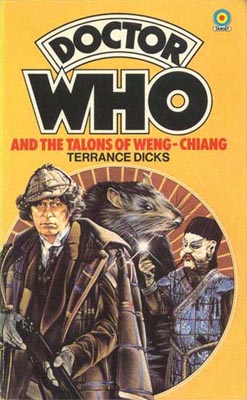The Talons of Weng-Chiang
Doctor Who and the Talons of Weng-Chiang

|
The Talons of Weng-Chiang |
Target novelisation Doctor Who and the Talons of Weng-Chiang |

|
| Author | Terrance Dicks |  |
| Published | 1977 | |
| ISBN | 0 426 11973 8 | |
| First Edition Cover | Jeff Cummins |
| Back cover blurb: Stepping out of the Tardis into Victorian London, Leela and the Doctor are confronted by menacing, diabolical horrors shrouded within the swirling London fog - a man's death cry, an attack by Chinese Tong hatchet men, giant rats roaming the sewers, young women mysteriously disappearing... The hideously deformed Magnus Greel, conducting a desperate search for the lost Time Cabinet, is the instigator of all this evil. Posing as the Chinese god, Weng-Chiang, Greel uses the crafty Chang, and the midget manikin, Mr Sin, to achieve his terrifying objectives. The Doctor must use all his skill, energy and intelligence to escape the talons of Weng-Chiang. |
A tough, savage place... by Tim Roll-Pickering 25/2/04
Victorian Britain features heavily in popular culture, with numerous novels, films and television series set there whilst innumerate documentaries and factual books have sought to expose one aspect or another. It is surprising that Doctor Who has not visited this time period more often, but when it does it rises to the occasion. Normally Terrance Dicks' adaptations of Robert Holmes' stories are amongst the best novelisations and this book is no exception. Throughout there are numerous little touches, such as an explanation of how the audience at the Palace Theatre is seated by class or how this is an age when the British Empire dominates the globe yet there are many living in London in abject poverty. Throughout the book there are many wonderful touches as Dicks seeks to flesh out the background, explaining just why Litefoot starts eating a ham with his hands (the Victorian rules of hospitality requiring him to never make his guest feel uncomfortable) or exposing the prejudices of the Victorians such as when a police constable wonders why the Chinese are always running laundries. The television story is one of the best written, full of humour and sophistication and much of this has been carried over into the novelisation. Throughout Dicks never once puts either British or Chinese culture as being superior to the other, instead contrasting the two. However people from Birmingham may have a gripe as the Doctor's line about the fowling piece has been altered so it is now just "made in England".
What is less successful is the element of mystery in the book. The original back cover blurb gives away who Weng-Chiang is and throughout the book he is referred to as "Greel" (presumably following the camera script) and so there is no real sense of who Weng-Chiang is, unlike in the televised version. However the tale's debt to the Sherlock Holmes stories is clearly marked, with many comments about how the Doctor uses a combination of comprehensive knowledge and excellent observation powers to deduce matters. The Holmes element is played up more than any other, presumably indicating Dicks' personal tastes. The narrative is all there but with other enhancements, such as the explanation as to just how the Cabinet of Death works and how Chang plans to attribute the Doctor's death to a mere failure of the mechanics. Whilst the television story flows fast enough to avoid the subtle explanations of small points these ommissions are often far more noticeable in a novelisation, but Dicks has wisely worked hard to ensure that the story still hangs together well.
The story remains as strong as ever, with a strong sense of darkness present throughout. This is a story about a latterday vampire consuming young girls, set in a world of brutal murders, poverty, prostitution and where giant rats guard the villain's layer. This is a far cry from a space fantasy adventure but instead a downbeat story yet told in a tongue in cheek manner. The result is a highly readable and successful book. This all the more poignant as in 1994 Doctor Who and the Talons of Weng-Chiang was the last novelisation to be reprinted under the Target imprint and so in a way it can be seen as the final ambassador for the range. Whilst not the greatest novelisation ever, it is nonetheless a strong book. 8/10